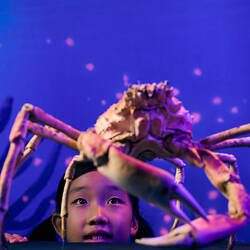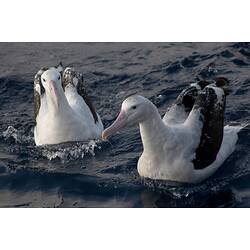Summary
This Wandering Albatross chick was donated to the museum in 1920.
Wandering Albatross can take up to nine years to reach their adult plumage, starting quite dark and becoming more white with age. Adults are mostly white but have fine black lines on their breast neck and back. They are the largest albatross species, with a wingspan that can reach over 3 m.
Wandering Albatross occur across the Southern Ocean, from Antarctic to subtropical waters, including southern mainland Australia and Tasmanian coastal areas where they are visitors between June and September. They breed on Antarctic and sub-Antarctic islands.
Pairs return to the island they hatched on once every two years to breed, producing an egg that weights about half a kilogram. Both parents incubate the egg and rear the chick once it hatches. Once they fledge, young birds will spend five to seven years at sea before returning.
Wandering Albatross feed at sea, mainly on cephalopods and fish, and will often follow fishing boats to feed on discarded offal. Unfortunately they often get caught by the lines of longline tuna fisheries and die. This is thought to be the main cause for their current declining populations. The International Union for Conservation of Nature (IUCN) considers them to be Vulnerable. In Victoria they are considered Critically Endangered.
Specimen Details
-
Taxon Name
-
Preferred Common name
Wandering Albatross
-
Number Of Specimens
1
-
Stage Or Age
Nestling
-
Specimen Nature
Nature: Mount, Form: Dry
-
Collected By
Unknown
-
Date Visited From
24/09/1898
-
Date Visited To
10/08/1898
-
Category
-
Scientific Group
-
Discipline
-
Collecting Areas
-
Type of Item
Taxonomy
-
Kingdom
-
Phylum
-
Subphylum
-
Class
-
Order
-
Family
-
Genus
-
Species Name
exulans
Geospatial Information
-
Country
-
Latitude
-41
-
Longitude
174
-
Geodetic Datum
WGS84
-
Georeference Source
Tissue Bank Database
![<em>Diomedea exulans</em>, Wandering Albatross. [60760]](/content/media/8/1968608-small.jpg)
![<em>Diomedea exulans</em>, Wandering Albatross. [60760]](/content/media/8/1968608-thumbnail.jpg)
![<em>Diomedea exulans</em>, Wandering Albatross. [60760]](/content/media/3/1968603-thumbnail.jpg)
![<em>Diomedea exulans</em>, Wandering Albatross. [60760]](/content/media/6/1968606-thumbnail.jpg)
![<em>Diomedea exulans</em>, Wandering Albatross. [60760]](/content/media/5/1968605-thumbnail.jpg)

